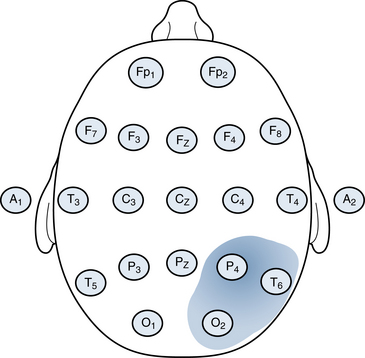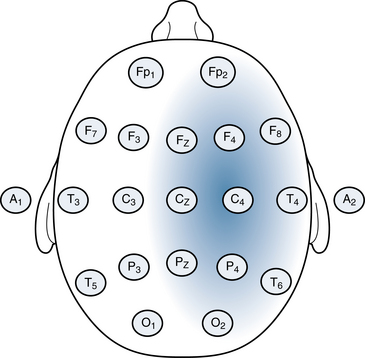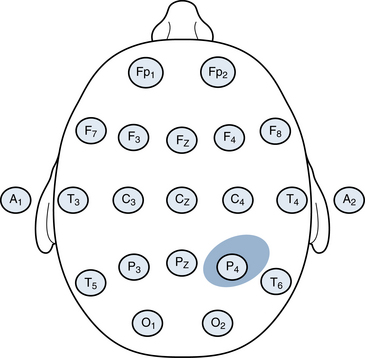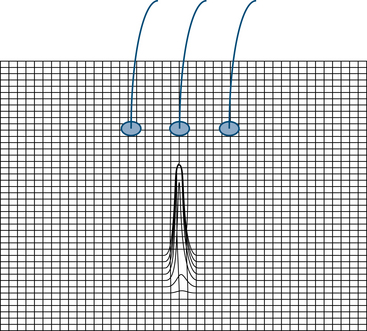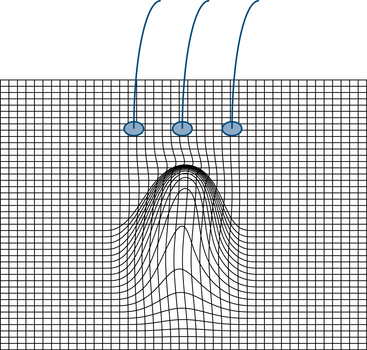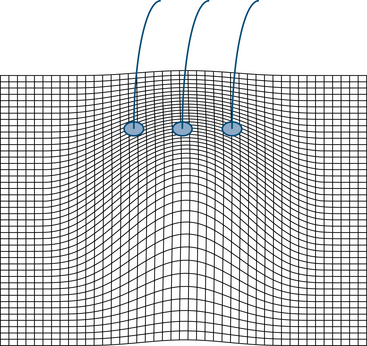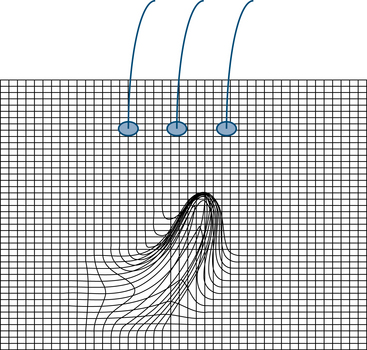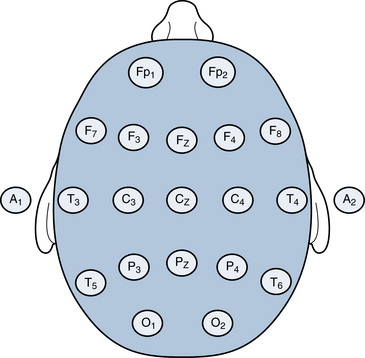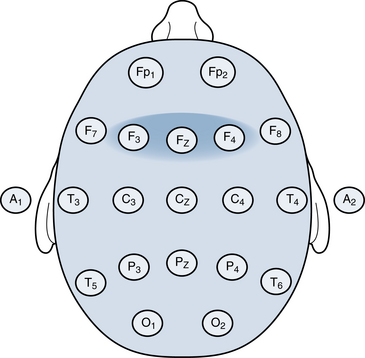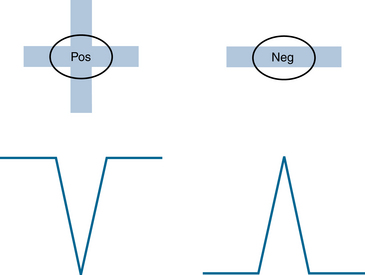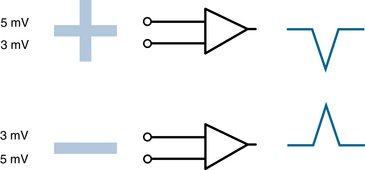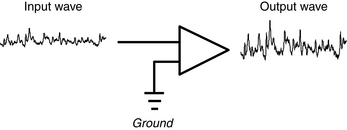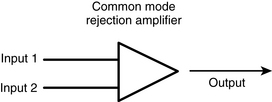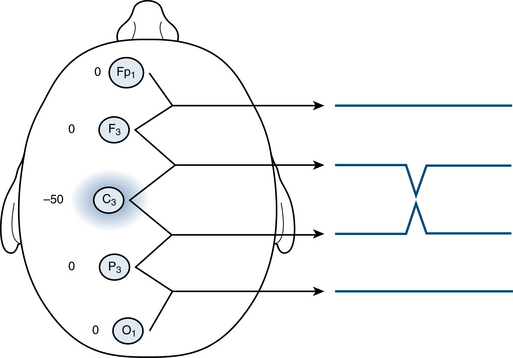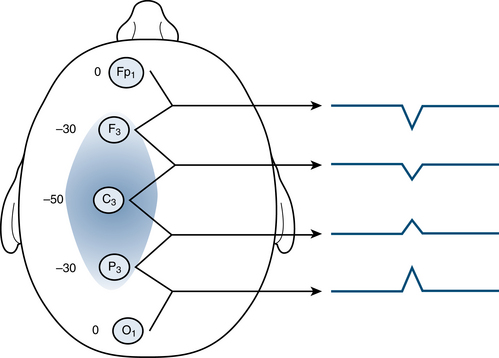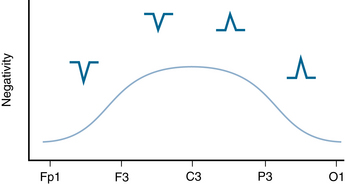Chapter 4 Electroencephalographic Localization
FOCAL EVENTS, ELECTRIC FIELDS, AND GENERALIZED EVENTS
Focal Events
A focal EEG event is one that occurs on a limited part of the brain surface rather than over the whole brain surface. Occasionally, an event may be so focal that it occurs in only one electrode. The large majority of discharges will also be detectable, though perhaps more weakly, in adjacent electrodes. The electrode position that picks up the highest voltage, be it positive or negative, is referred to as the discharge’s maximum. Although the discharge may be best seen at the maximum, adjacent electrodes often pick up varying amounts of the discharge. The hypothetical discharge shown in Figure 4-1 shows a discharge maximum in the right parietal electrode (P4) with a field that includes the right posterior temporal electrode (T6) and, to a lesser extent, the right occipital electrode (O2). A focal discharge having a broader field, such as the one shown in Figure 4-2, can have a maximum at one electrode (C4 in this example) but involve a substantial part of one hemisphere.
Rarely, an EEG event may occur so focally that its activity is only recorded in a single electrode, such as the example of the highly focal right parietal discharge shown in Figure 4-3. According to the schematic, the discharge would only be detected by the single electrode (P4), and adjacent electrodes would be electrically quiet. In practice, such highly focal discharges are uncommon and represent the exception rather than the rule (although this phenomenon of highly focal discharges is more commonly seen in newborns). The first two examples given above in which a discharge is detected by a group of electrodes is the more commonly encountered situation. The pattern of how strongly the discharge is picked up in various electrodes helps define the shape of the discharge’s electric field as discussed next.
Electric Fields
Rather than showing a smooth and steady decrease in voltage in every direction from the central maximum point, it is possible for fields to dissipate gently in one direction and abruptly in another. A better analogy for the shape of electric fields is the visualization of mountain peaks. Mountain peaks give a more realistic picture of EEG fields because they need not be so perfectly symmetrical in shape as the circular waves caused by a pebble hitting water. Imagining the terrain around a 5,000-foot mountain peak, we might expect that the height of land surrounding the peak will fall off with varying steepness in each direction. Likewise, electric fields may manifest a steeper slope of voltage decrease in one direction and a more gentle slope in another direction. An abrupt and immediate falloff in voltage from a central point in all directions as shown in Figure 4-4 would correspond to a thin needle of land 5,000 feet high with nothing surrounding it, an uncommon finding both in geography and in electroencephalography but akin to the discharge in Figure 4-3.
The illustration in Figure 4-4 depicts a highly focal discharge, similar to that shown in Figure 4-3. The plane of the rectangular grid is a representation of the voltages measured on the scalp surface. In this figure, areas close to the discharge’s peak are not involved, and relatively nearby electrodes would not “perceive” any change in voltage. Such highly restricted or “punched-out” discharges are relatively uncommon (just as 5,000-foot mountains in the shape of a needle are uncommon). The field shown in Figure 4-5 is somewhat more realistic, with a peak or maximum in the same position, but a more gradual falloff in voltage as distance increases from the maximum point. In this example, adjacent electrodes would pick up increasingly weaker voltages with increasing distance from the point of maximum. Figure 4-6 shows a discharge with a broad field, and, although the middle electrode would pick up the highest voltage, the adjacent electrodes would detect a voltage intensity of more than half that detected by the middle electrode. Figure 4-7 reminds us that, quite often, the electric field can slope off asymmetrically from its peak.
Generalized Events
In contrast to the focal events described earlier, some events occur in all brain areas at once and are said to occur in a generalized distribution. Figure 4-8 depicts a discharge with a perfectly even electric field. With cerebral discharges, even in the case of generalized discharges, there is almost always some unevenness to the field, and an area of maximum intensity can still be identified. In Figure 4-9, the discharge affects all brain areas and is, therefore, generalized, but the intensity is highest in the F3, Fz, and F4 electrodes.
The purpose of this chapter is to help the reader become adept at translating the patterns of pen deflections recorded on the EEG page into the particular localizations, polarities, and the shapes of the gradients that those patterns imply. In short, we examine the patterns that EEG pens will draw when they encounter electrical fields of various shapes, including the types depicted in the figures discussed earlier. Ideally, after analyzing an EEG discharge on an EEG page, the reader will be able to imagine a “mountain range” configuration that accurately depicts the shape and the gradients of the discharge’s electric field.
EEG WAVES AND EEG POLARITY
Pen Up or Pen Down?
EEG Channels Are Fancy Voltmeters
A voltmeter measures the potential difference or “voltage drop” between two points. Because voltages are always differences, whenever a voltage measurement is made, the reader should be aware which two identifiable points are being compared. Even when it appears that the voltage at a single point is being described, it is implicit that the point is being compared with some standard (perhaps a ground or other “neutral” point). Likewise, even though there may be a temptation to think of the output of an EEG channel as representing the activity at some single point on the scalp, every channel deflection we see on the EEG is, in reality, a comparison of two different points on the body (or occasionally a combination of more than two points, as we shall see in later chapters). Any wave seen on the EEG is, therefore, a comparison of the electrical potential at two locations rather than an absolute measurement made at a single location. The waves that we are analyzing are, indeed, the outputs of constantly fluctuating voltmeters comparing two inputs (see Figure 4-10).
The reader may be wondering which would be more logical, for the pen to go up or for the pen to go down, in the example in the preceding paragraph in which the difference is positive 5 μV. The answer to this question cannot be derived using mathematical or physical principles. Rather, it is an arbitrary convention that was decided by EEG machine manufacturers in the early days of EEG. The answer for the earlier example is that the pen goes down. The convention assumes that there are two input terminals to the amplifier, Grid 1 and Grid 2, which can also be called Input 1 and Input 2. The convention is: “First input more negative: pen goes up. First input more positive: pen goes down.” Some may find this convention counterintuitive because in most areas of mathematics and science, values are graphed above the x axis when they are positive and below the x axis when they are negative. Alas, in electroencephalography, the opposite is true; this “upside-down” convention is here to stay and can take some getting used to. It may be helpful to use the counterintuitive nature of the convention to help remember it.
Here is how the convention works in more detail: as noted, every EEG amplifier has two principle inputs, which we will refer to as INPUT 1 and INPUT 2. The EEG technologist decides which electrodes are plugged into INPUT 1 and INPUT2 for any given channel according to which EEG montage is chosen. The situation of INPUT 1 being more negative than INPUT 2 can be stated in a number of ways, such as: “the difference between INPUT 1 and INPUT 2 is negative” or as the mathematical expression: “INPUT 1 − INPUT 2 < 0.” In such cases the amplifier’s pen deflects upward. Of course, the opposite holds true for the reverse situation: when INPUT 1 is more positive than INPUT 2, the pen deflects downward as in the example above (see Figure 4-11).
When INPUT 1 is more positive than INPUT 2, the pen goes down.
When INPUT 1 is more negative than INPUT 2, the pen goes up.
Of all the ways to state this rule, the subtraction expression “if INPUT 1 − INPUT 2 > 0 . . .” is most correct because it deals with all the possible combinations of each of the two inputs being positive, negative, or zero. One could quibble with the idea of saying that −3 is “more positive” than −5 because neither is positive. In this text, we use this simpler shorthand, stating that one electrode is “more positive” or “more negative” than another without regard to the sign of the electrodes’ absolute voltages for simplicity’s sake. Figure 4-12 shows another representation of this convention.
EEG Amplifiers
To understand the meaning of pen deflections, it is useful to consider the nature of the amplifiers used in the electroencephalograph. Perhaps the simplest conceivable amplifier design would be the single-end input amplifier. This type of amplifier would take a single signal as its input and furnish an amplified version of that signal as its output (see Figures 4-13 and 4-14). This is not, however, the type of amplifier used in EEG machines, and for good reason. A single-end amplifier is essentially using the building’s electrical ground as the comparison input; however, such grounds are usually much too electrically contaminated or “dirty” to be useful for this purpose.
Actual EEG amplifiers, like the voltmeters described earlier, use two inputs (see Figure 4-15). The signal from INPUT 2 is subtracted from the INPUT 1 signal; the result is then amplified and serves as the output. This type of amplifier is also called a common mode rejection (CMR) amplifier. As we shall see, the strategy of subtracting one input signal from the other has several important advantages. Figure 4-16 shows how a CMR amplifier behaves with two sample electrical inputs. Note that the component of each signal that is common to both inputs is cancelled out, or “rejected.” Only the difference between the two signals appears in the output. Why is elimination of the part of the signal that is common to both electrodes an advantage? This technique of amplification is especially useful in the field of electroencephalography in which the signals of interest—brain waves—are of very low voltage compared with the ambient electrical noise from external sources that runs through the patient’s body. Because the pattern of this external noise signal tends to be similar in the various scalp electrodes, CMR amplifiers cancel out much or all of the external noise component of the signal, ideally leaving only the cerebral component for interpretation.
Event Localization Using a Bipolar Montage
The examples that follow consider a theoretical spike discharge on the scalp and how it would appear on the EEG record. The first example we examine is a hypothetical spike in the left central region of the brain (the area under the C3 electrode). A spike is, by definition, a quick event, and in this example, it will have a negative polarity (the scalp region where the spike occurs will be momentarily negative compared with the surrounding scalp, which, for the purposes of this example, is neutral). The electrode set we use to record the spike is a single chain of standard electrodes that goes along the scalp from front to back just to the left of the midline: Fp1, F3, C3, P3, and O1 (the left frontopolar, superior frontal, central, parietal, and occipital electrodes, respectively). The technique used for the following examples is the typical strategy of creating a bipolar chain with these electrodes by looking at a succession of pairings of adjacent electrodes from front to back: Fp1 to F3, F3 to C3, C3 to P3, and P3 to O1. The term bipolar is used because each EEG channel generated represents a comparison of two cerebral locations. Each of the two electrode locations can be said to be “of interest” because both reflect brain activity, and it is possible that a clinically important event could arise from under any of the five electrodes. (In the contrasting situation of referential montages described in more detail later, INPUT 1 is connected to an electrode over the brain, and INPUT 2 is connected to some other reference point that is presumably not “of interest” but is used for the purpose of subtracting noise.) Note that there are five electrodes in this chain but there are necessarily only four consecutive pairings. Thus, a chain of five consecutive electrodes will produce four channels of EEG in a bipolar chain.
“Negative Phase Reversal”
Figure 4-17 depicts the field of a 50-μV spike occurring at C3 with no activity at all in the surrounding electrodes. On the right, the four channels representing the output of the bipolar chain are depicted. It is worthwhile to go through each line of the output to understand exactly why voltage measurement shown on the left side of the figure is associated with the EEG trace on the right side of the figure.
The second channel, F3-C3, is comparing 0 μV in INPUT 1 (F3) and −50 μV in INPUT 2 (C3). Because the convention is that if the first electrode is “more positive” than the second, the pen goes down, a downward pen deflection is produced.
As discussed earlier, focal EEG events on the brain surface rarely occur solely in an isolated pinpoint area of the scalp as in the example in Figure 4-17. Instead, there is typically a point of voltage maximum around which lower voltages can be detected. The example shown in Figure 4-18 is more similar to real-world events. Although the C3 electrode is the point of maximum intensity of this event, the adjacent areas measured by F3 and P3 are also affected, but not as strongly. This gradual drop-off in intensity of voltage shows that the event has a somewhat broader field, even though we are still dealing with a −50-μV spike in C3. A good description of this spike would be that the spike has a maximum negativity at C3 but a field that also includes F3 and P3.
Now let’s return to Figure 4-18, which shows a more realistic gradient around a spike focus at C3. The resulting EEG trace is similar to the one we saw earlier but with some notable differences:
Comparing the pattern of EEG waves in Figure 4-18 to the previous figure, we see that there are now deflections in all four channels. This reflects the fact that the field of this spike involves both adjacent electrodes, F3 and P3, and that the gradient of the field stretches out more broadly than in the first example. Stated another way, there is now an electrical gradient (difference) between all four channel pairs. The fact that there is a deflection in each channel reflects the fact that no two adjacent electrodes measure the exact same voltage and that there was an increase or decrease in voltage in every comparison. Because in channels 1 and 2 the pen goes down and in channels 3 and 4 the pen goes up, we say there is a phase reversal occurring between channels 2 and 3. A phase reversal is the point along a bipolar electrode chain at which the direction of the pen deflection changes (from down to up or from up to down). Because in this example C3 is the electrode common to channels 2 and 3, the two channels between which the phase “reversed,” this is the point of maximum of the discharge.
Imagine that the farmer turns on the instrument (which senses his starting position) and then walks forward the first 10 feet. The instrument, comparing the starting position to his present position, reports “it’s getting higher” (the pen goes down). After the next 10 feet, it reports that it is getting higher again (the pen goes down again). After the next 10 feet, it reports “it’s getting lower” (the pen now goes up). This is the point of the “phase reversal” when the pen direction has changed. The farmer does not know the absolute altitude at the previous point, but he does know that the area between the points at which his instrument”s pen flipped from down to up must mark the highest point on the track he has walked so far. After the pen readings shift from downward to upward, he knows he has located a height maximum along the line he is exploring. This is the equivalent of a phase reversal in a bipolar chain on the EEG. Before making a final decision, he will probably want to get to the end of the field to make sure that he found the highest point on the whole path. If he wanted to make a topographic map of the whole field, he could perform the same top to bottom walk along the field in several parallel lines. To be even more complete, he might repeat the measurements walking on parallel tracks from right to left (at right angles to the original paths). Using this strategy and recording the amount his pen deflects on every measurement, he would eventually be able to draw a relative topographic map of the whole field, something like the grid shown in Figure 4-6.
In these examples, greater altitude in the farmer’s field is analogous to EEG voltage becoming more negative. The EEG reader can imagine “walking down” or scanning a bipolar chain along the scalp such as from Fp1 all the way to O1 and, like the farmer, feel as the pens go down that “it’s getting more negative” and then as the pens finally reverse direction that “it’s getting more positive.” When the pens switch direction, this implies that the point of maximum negativity was passed, identifying the position of the maximum voltage of the spike. Figure 4-19 shows the deflections that the farmer’s instrument might generate while walking along a single path, or likewise what an EEG machine might detect when exploring the parasagittal chain when there is a spike maximum at C3.
Stay updated, free articles. Join our Telegram channel

Full access? Get Clinical Tree


